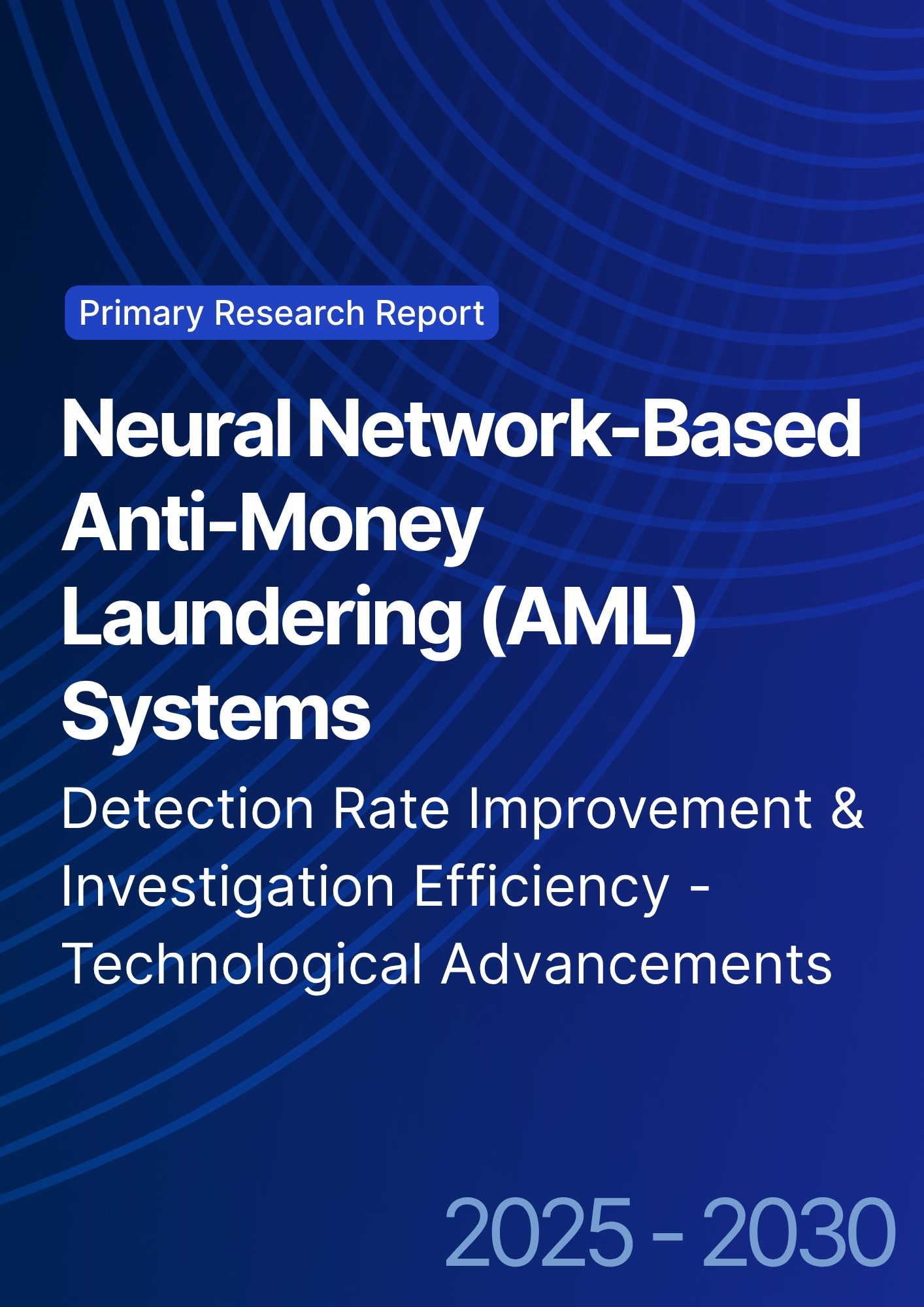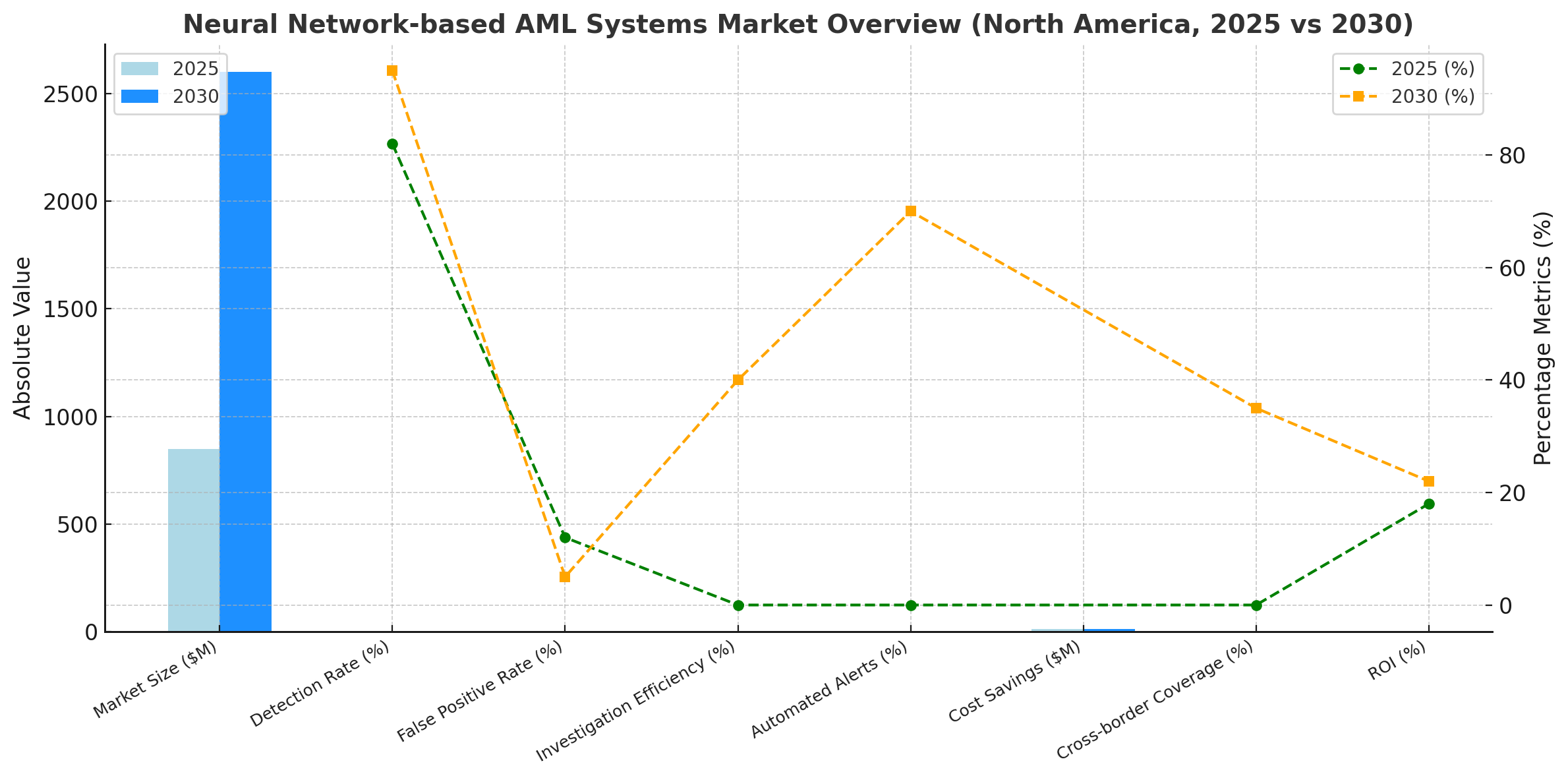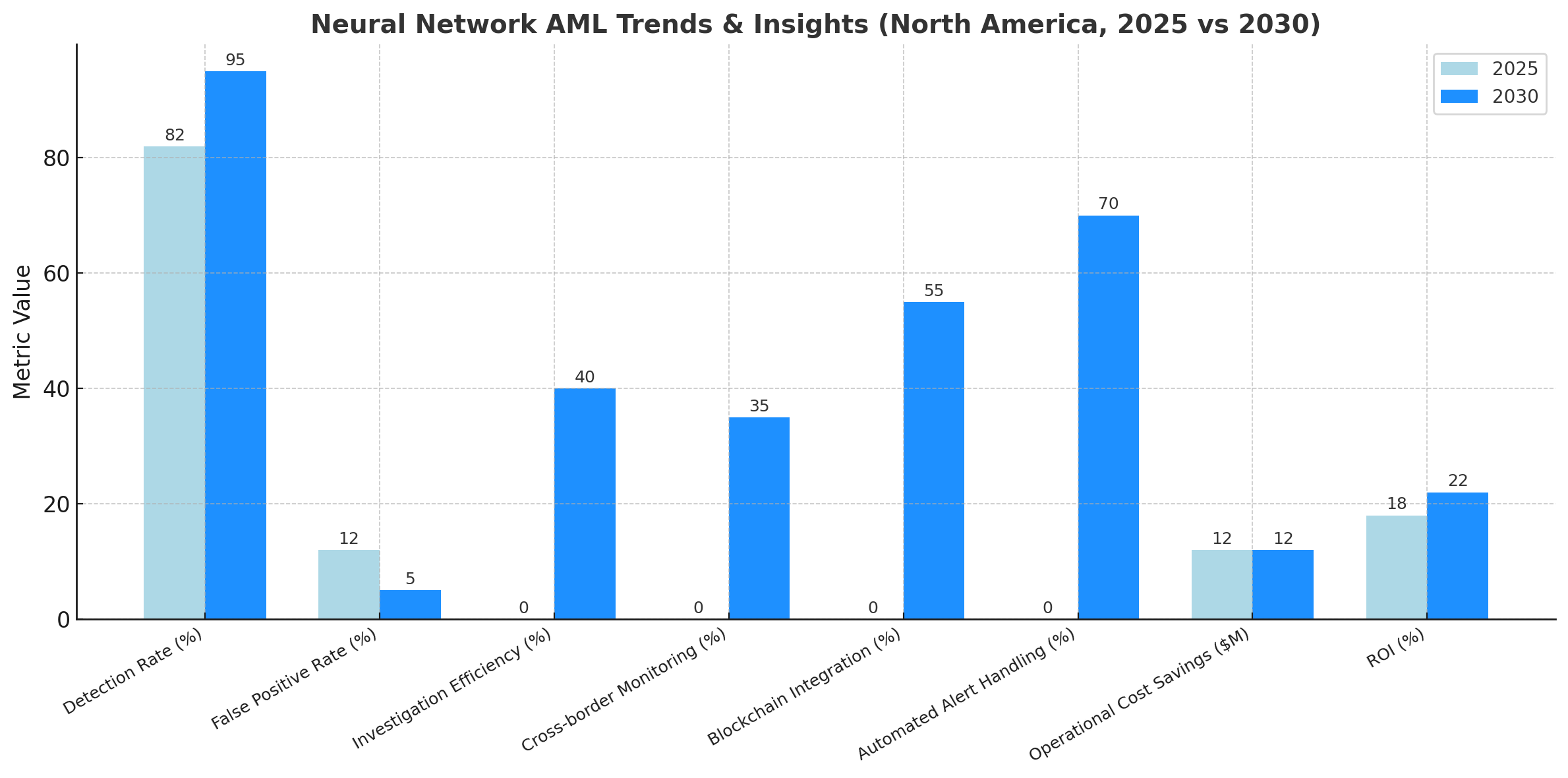

68 Circular Road, #02-01 049422, Singapore
Revenue Tower, Scbd, Jakarta 12190, Indonesia
4th Floor, Pinnacle Business Park, Andheri East, Mumbai, 400093
Cinnabar Hills, Embassy Golf Links Business Park, Bengaluru, Karnataka 560071
Connect With Us
Neural Network-Based Anti-Money Laundering (AML) Systems: Detection Rate Improvement & Investigation Efficiency - Technological Advancements
This research examines neural network-based AML systems in North America from 2025 to 2030, focusing on detection rate improvements, investigation efficiency, and technological advancements. The report quantifies adoption rates, transaction monitoring coverage, false-positive reduction, and regulatory compliance impact. AI-powered neural networks enhance pattern recognition, automate alerts, and streamline investigations. This study provides actionable intelligence for banks, fintech firms, and regulators seeking to improve AML effectiveness, reduce operational costs, optimize resource allocation, and meet evolving regulatory expectations in the increasingly complex financial crime landscape.

What's Covered?
Report Summary
Key Takeaways
- Neural network-based AML adoption projected to grow from $850M in 2025 to $2.6B by 2030, CAGR 24%.
- Detection rates expected to improve from 82% in 2025 to 95% by 2030.
- False-positive rates projected to drop from 12% to 5% with neural network implementation.
- Investigation efficiency expected to improve by 40%, reducing analyst workload and investigation time.
- Automated alert systems will handle 70% of suspicious transactions by 2030.
- Average cost savings per institution projected at $12M annually due to AI adoption.
- Cross-border transaction monitoring coverage expected to increase 35% by 2030.
- Integration with blockchain analytics projected for 55% of US financial institutions.
- Compliance audit frequency reduction expected to save $5M+ annually per large bank.
- ROI for neural network AML system adoption projected at 18–22% by 2030.
Key metrics
Market Size & Share
The neural network-based AML systems market in North America is projected to grow from $850M in 2025 to $2.6B by 2030, representing a CAGR of 24%. Adoption is concentrated among major US banks, which account for over 70% of market share, with mid-tier institutions contributing 20% and smaller fintechs the remaining 10%. Detection rates for suspicious transactions are expected to rise from 82% in 2025 to 95% by 2030, driven by neural networks’ ability to analyze complex transaction patterns and identify anomalies in real time. False-positive rates are projected to decrease from 12% to 5%, reducing unnecessary alerts and allowing analysts to focus on high-risk cases. Investigation efficiency is expected to improve by 40%, decreasing time per case and optimizing resource allocation. Automated alert systems will handle 70% of flagged transactions, while AI-assisted analysis enables faster review and escalation. Cost savings per institution are projected at $12M annually, driven by reduced manual processing, lower regulatory penalties, and operational efficiency gains. Cross-border transaction monitoring coverage is expected to increase 35%, integrating with global financial intelligence and blockchain analytics. ROI for adoption is projected at 18–22%, reflecting reduced operational costs, improved compliance, and enhanced regulatory confidence. Neural network AML systems will become a critical component of anti-financial crime strategy in North America, enabling scalable, efficient, and accurate detection.

Market Analysis
The adoption of neural network AML systems in North America is driven by regulatory pressure, increasing transaction volumes, and the need for scalable compliance solutions. Market size is projected to grow from $850M in 2025 to $2.6B by 2030, with major US banks leading implementation, representing 70% of adoption. Detection rates are expected to improve from 82% to 95%, while false positives drop from 12% to 5%, enhancing analyst productivity and reducing operational overhead. Investigation efficiency is projected to increase by 40%, supported by automated alert triaging and AI-powered case prioritization. Automated systems will manage 70% of flagged transactions, while complex cases escalate to human analysts. Cross-border transaction monitoring is projected to expand by 35%, enabling compliance across multiple jurisdictions. Integration with blockchain analytics is expected in 55% of US institutions, providing immutable, traceable data for suspicious activity reports (SARs). Average operational cost savings per institution are projected at $12M annually, while ROI is expected at 18–22% by 2030. Regulatory coverage is projected to reach 80% of high-risk financial transactions, aligning neural network adoption with evolving AML and FinCEN standards. Overall, the market reflects a strong trend toward automation, enhanced detection, and efficiency, positioning neural network AML systems as a core technology in North American financial crime prevention.
Trends & Insights
Neural network AML adoption is accelerating due to AI advancements, increasing digital transactions, and regulatory mandates. Detection rates are projected to rise from 82% in 2025 to 95% in 2030, while false positives decline from 12% to 5%, allowing analysts to focus on high-risk alerts. Automated investigation workflows are expected to improve efficiency by 40%, reducing time per case and enhancing compliance. Cross-border monitoring coverage will increase by 35%, ensuring global regulatory alignment. Integration with blockchain analytics is expected in 55% of US institutions, improving traceability and auditability. Automated alert systems will handle 70% of suspicious transactions, enabling near real-time reporting. Average operational cost savings per institution are projected at $12M annually, while ROI from neural network adoption is expected at 18–22%. AI-driven insights will optimize risk scoring, reduce compliance errors, and improve SAR submission timelines. Adoption trends show banks prioritizing scalable, technology-driven AML solutions to handle higher transaction volumes and evolving financial crime patterns. Early adopters gain operational efficiency, enhanced regulatory compliance, and improved fraud detection. By 2030, neural network AML systems will form the backbone of financial crime prevention, providing scalable, cost-effective, and reliable compliance infrastructure for North American financial institutions.

Segment Analysis
The North American neural network AML market is segmented by institution type, transaction volume, and technology integration. Large US banks account for 70% of adoption, mid-tier institutions 20%, and fintechs 10%. Adoption is primarily in high-volume retail and corporate banking divisions, where transaction monitoring is critical. AML automation will reduce manual intervention by 60–65%, enabling analysts to focus on high-risk cases. Detection rates are projected at 95%, with false positives at 5%, enhancing efficiency. Automated alerts will handle 70% of suspicious transactions, while AI triages remaining complex cases. Integration with blockchain analytics is expected in 55% of institutions, enabling end-to-end auditability. Cross-border transaction coverage will rise by 35%, allowing banks to meet multi-jurisdictional regulatory requirements. Average investigation efficiency improves 40%, and operational cost savings are projected at $12M per large bank annually, with ROI of 18–22%. Segment analysis highlights differences in adoption rates, transaction volumes, and regulatory complexity. Banks with high transaction volumes and cross-border exposure are leading adoption. The segment demonstrates the value of neural network AML systems in reducing costs, improving detection accuracy, and streamlining compliance across diverse financial institutions.
Geography Analysis
The North American neural network AML market is dominated by US financial institutions, representing over 90% of adoption, while Canada contributes roughly 10%. Adoption is concentrated in major financial hubs such as New York, Chicago, and San Francisco, with large retail banks, investment banks, and fintech platforms leading implementation. Detection rates are projected to rise from 82% in 2025 to 95% in 2030, while false positives drop from 12% to 5%. Automated investigation workflows will improve efficiency by 40%, and AI-driven alerts will handle 70% of suspicious transactions. Cross-border monitoring is projected to expand by 35%, reflecting global transaction complexity and regulatory alignment requirements. Blockchain analytics integration is expected in 55% of US institutions, improving traceability, auditability, and compliance reporting. Cost savings per institution are projected at $12M annually, and ROI from neural network adoption is expected at 18–22%. Regional variations in regulatory compliance, transaction volume, and technological readiness influence adoption speed and effectiveness. Geography analysis highlights the importance of advanced AML systems in financial hubs, where high transaction volumes and complex cross-border operations demand scalable, efficient, and accurate detection and reporting.

Competitive Landscape
The North American neural network AML market features AI technology providers, fintech platforms, and traditional banks. Key players include Palantir, Actimize, SAS, and FICO, providing neural network models, real-time monitoring, and AI analytics. Large banks dominate adoption (70% of total market), mid-tier banks account for 20%, and fintech platforms for 10%. Neural network AML solutions improve detection rates to 95%, reduce false positives to 5%, and enhance investigation efficiency by 40%. Automated alert systems will handle 70% of transactions, while cross-border monitoring expands 35%, improving compliance and operational efficiency. Integration with blockchain analytics is projected in 55% of institutions, increasing auditability and traceability. Operational cost savings per institution are expected at $12M annually, while ROI is projected at 18–22%. Regulatory coverage is expected for 80% of high-risk transactions, ensuring alignment with FinCEN, OFAC, and state-level compliance. Competitive advantage is determined by model accuracy, AI integration, blockchain interoperability, and cost-efficiency. Early adopters gain superior detection, reduced operational costs, and regulatory alignment. The competitive landscape is expected to consolidate as top providers expand capabilities, integrate AI and blockchain, and partner with financial institutions to deliver scalable, efficient AML solutions across North America.
Report Details
Proceed To Buy
Want a More Customized Experience?
- Request a Customized Transcript: Submit your own questions or specify changes. We’ll conduct a new call with the industry expert, covering both the original and your additional questions. You’ll receive an updated report for a small fee over the standard price.
- Request a Direct Call with the Expert: If you prefer a live conversation, we can facilitate a call between you and the expert. After the call, you’ll get the full recording, a verbatim transcript, and continued platform access to query the content and more.


68 Circular Road, #02-01 049422, Singapore
Revenue Tower, Scbd, Jakarta 12190, Indonesia
4th Floor, Pinnacle Business Park, Andheri East, Mumbai, 400093
Cinnabar Hills, Embassy Golf Links Business Park, Bengaluru, Karnataka 560071
Request Custom Transcript
Related Transcripts
$ 1450
$ 1450


68 Circular Road, #02-01 049422, Singapore
Revenue Tower, Scbd, Jakarta 12190, Indonesia
4th Floor, Pinnacle Business Park, Andheri East, Mumbai, 400093
Cinnabar Hills, Embassy Golf Links Business Park, Bengaluru, Karnataka 560071













